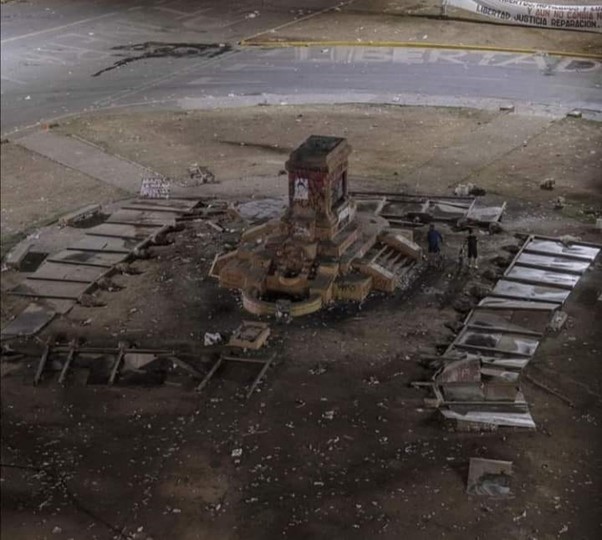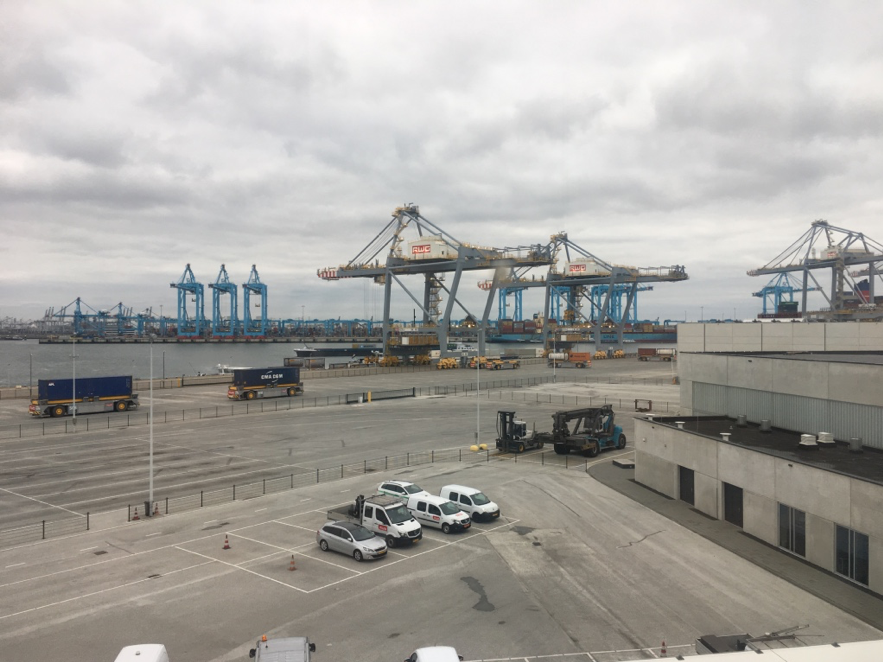
23/04/22
The performative power of determinate negation
Anthony McInneny
Plaza Baquedano was established in 1929 and replaced Plaza Italia which was named after a gift from the Italian Kingdom to Chile to celebrate the 1st centenary of the Republic of Chile. That monument gift is still located in Plaza Baquedano. Plaza Baqeudano is a more fitting name for the public space/monument that is the main place for public celebrations and demonstrations in Santiago, the capital of Chile. It is dedicated to General Manuel Baquedano who lead the Chilean Army to victory against the Peruvian-Bolivian alliance in the late 19C Pacific War. Plaza Baqedano, with the monument to General Baquedano by renowned sculptor Virginio Arias, also contained the unknown soldier’s remains from the Pacific War and the busiest Metro station in the Metropolitan network, Metro Baquedano. The urban insurrection, which began on 18 October 2019 with the arson attack on 20 Metro stations in 6 hours, is unrelenting, violent, and destructive. The decimation of the are within a 1 kilometre radius of Plaza Baquedona is entire. This área is called Ground Zero. The material damage in this área alone is 106 million USD. 80% of businesses are still protected behind welded sheet metal facades. The entrance to Metro Baquedano is permanently welded shut and the concourse is reduced to rubble, smashed up by hand with hammer and crowbar for missiles to throw at pólice. After the attempts to topple the monument to General Baquedano were not successful, the last attempt on International Women’s Day 2021, the National Council of Monuments decided to remove the sculpture to protect it and placed a 3 meter high, welded sheet metal cube around the emptied plinth and the tomb of the unknown soldier that was able to withstand the impact of a vehicle traveling at 80 kilometers/hour. On the second anniversary of 18 October, the usual Friday night riots, arson, and looting that is now called traditional protest destroyed the metal wall. In consultation with the Armed Forces, the National Council of Monuments decided to exhume the remains of the unknown soldier for fear that they would be exhumed by the regular rioters now called political prisoners if they are arrested for such crimes. Supporters of this violence and destruction, including the recently elected President and former Student Protest Leader, not only are calling for an amnesty for all crimes committed since 18 October but want to rename Plaza Baquedano, Plaza de la Dignidad (Plaza of Dignity). This is a fitting name for the materialization of what Marxist Philosopher called the Power of Determinate Negation and which the Cultural Industry applauds as art activism, the art of protest.

14/06/21
The Production of Urban Space under Capitalism: As seen through the lens of an urbanist at the Rotterdam World Gateway Container Port Terminal
Alejandra Rivera
Rotterdam Port is the largest in Europe and the ninth in the world. It extends over a length of 42 km with nine terminals dedicated to various uses and industries. On December 2017, I was able to have a guided visit to the impressive Port of Rotterdam. This picture was taken from the office building of Terminal # 9 (Rotterdam World Gateway – RWG) during cargo loading operations of a barge working with two gantry cranes (middle of the picture).
RWG is a “fully electrical terminal with a high degree of automation” (RWG). The two containers on the left are being carried by two of the 59 Automated Guided Vehicles (AGVs) at RWG. AGVs work with no driver nor remote control, but are electric vehicles with specific commands and utilize sensors to navigate their surroundings. Also, the gantry cranes are operated remotely from the office building I was standing on. These electric tools contribute to keep the container terminal surprisingly organized, clean, and quiet.
This picture captures the concept of David Harvey’s Theory of Urbanization under Capitalism. First, the Spatial Fix is an injection of capital into the built environment, either recycling buildings or constructing new ones. RWG represents an investment in high-technology infrastructure in the urban environment, and it has an impact in society by creating employment and propelling the local, regional and international economy. The spatial fix also serves, or is a direct reflection of, the technology fix.
Technology Fix is the reinvestment of surplus capital in new and improved productive capacities, i.e. in new sectors, products, processes or tools creating innovation and new rounds of economic growth. The AGVs and long-distance operated cranes are investments in innovative operational processes to increase terminal productivity. Automation allows faster loading and discharging of containers in and out of vessels, decreases the risk of errors, increases customer satisfaction and reduces operational costs. Also, by not having any stevedores, RWG reduces safety hazards for employees and liability for the terminal.
RWG is also an asset in itself, this is the Financial Fix. The total investment in this terminal has been approximately 700 million euros (RWG). It is the most technologically advanced, efficient, and therefore, the most expensive terminal in Rotterdam. RWG extracts ‘rents’ from expensive fees charged to vessel operators and freight forwarders, and is also a potential for capital gains, as it gains value due to its high degree of automation, efficiency, good quality service, and acquired reputation among customers and vendors.
This shows that uneven urban development is structural, not accidental. It follows different patterns of investment and disinvestments which, depending on profitability, produce different space configurations. The spatial fix, RWG in this case, implies immobilization of large amounts of capital into the container terminal, which is expected to have capital gains, but can also devalue and eventually be destroyed and replaced. This is yet another example of David Harvey’s famous observation that “Capitalism never solves its crises problems, it just moves them around geographically”.